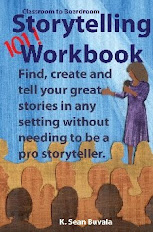In this next "Hard-Core Storytelling Practitioner" post, I am talking the concept of "Show, Don't Tell" (written as Show or Tell in this article) that is prevalent in the "sacred" texts (giggle) of many who practice oral storytelling.
Background
 |
| This is all Show. You would need some Tell to understand this pic, huh? |
Adding to my reflection this week came Cassandra Cushing, who serendipitously asked on Twitter, "Storytellers, what does 'show, don't tell' mean to you? Do you like this phrase/concept?"
You can see most of the friendly conversation between Cassie, Tim Ereneta and me in this link here. In the debate for meaning and its application for oral storytelling, the "Tell" part of the phrase is easy: Words. Storytellers use words intentionally, judiciously and musically. But, don't use too many words, Show some words instead. Use too many words and, like extra salt in a soup, the experience of storytelling is spoiled. With not enough words, the story can feel flat just as soup would be when lacking salt.
So, for me, the question comes down to this: what does "Show" mean?
My Understanding
In the debate for meaning of "show, don't tell" and its application for oral storytelling, the "Tell" part of the phrase is easy for me: Words. Storytellers use words intentionally, judiciously and musically. They also need to do so in front of a live (present with them) audience. Because of that unique requirement of audience presence, the storyteller is free to Show the story through simple gesture and characterization.
I have a choice. I can Tell you a description of every character and how they are reacting to the world around them or I can Show how they are feeling and reacting in their story world.
Use too many words and, like excess salt in a soup, the experience of storytelling is spoiled. With not enough words, the story can feel flat just as soup would be when lacking salt. Tell the story, give enough narrative, walk with the audience towards the full realization of the story you are Telling. Use Show much more liberally. Watch your audience as you are storytelling, trust them to "get it." If they don't, maybe they need more salt in their soup?
Let's look at one character in one story, as an example of Show. When I tell one of the original Grimm versions of "Cinderella," the step-mother is clearly unhappy with Cinderella's ability to outsmart her. As she speaks in my story, demanding even more dried peas be picked from the ashes, I see her in my mind's eye. I Show that to my audience: my body straightens, her speech becomes clipped and she does the "plastic smile" at Cinderella. Her gestures become staccato and she unconsciously picks at her fingers, rubbing thumb to side of finger as she holds one hand in front of her. I am Showing the character to the audience. Step-mom's persona lives in me in these subtle ways.
Each character has their own "way of being" that is Shown in my way of bringing the character to life. This is so much a part of my telling that, in order to write this for you, I had to briefly tell the story to myself, so that I could remember the nuances of the character. I had to figure out how to tell you all those words to describe Step-mom in this article. Whew! Thank goodness I don't do that for actually storytelling.
Some Ways to Show
As a storyteller, you have a full pallet of ways to Show a character. You will be using hand gestures, facial expressions, gaze, and body posture and body position. Your tone of voice might change between characters. You will be being giving attention to your pacing, pauses and your eye contact. Incorporate the character into your being, Show the characters to your audience.
Exceptions
I am aware that for some audiences that may be visually challenged you may need to add more words to your story, using Tell more liberally. Also, for audience members on the Autism spectrum or others who have trouble with interpreting social cues, a more direct approach to "The Step-mom was angry, trying to control her voice…she sounded like this," might be a better choice. As storytellers, we always put our audience first. What do they need?
But what about oral recordings?
These concepts of Show and/or Tell have different rules in a recording, particularly in an audio recording such as a CD, mp3, radio or podcast. Storytelling performances recorded in audio (or video) are not storytelling. They are records of a storytelling event, no matter how entertaining they may be. For example, my current version of the Rumpelstiltskin tale is of a tiny man of few words, but with a very expressive face, head gestures and lingering eye contact. That Showing simply does not translate well to an audio recording. To record it formally, I would have to change the balance and techniques of Show and Tell.
A story designed for recordings (audio) is closer to "voiceover" than storytelling.
Tl;dr or My Conclusion
Here is what I am practicing and using these days: Showing and Telling are both important parts of oral storytelling. Showing in a story is the whole body, subtle and nuanced, expression of a character or place in live storytelling. Telling is where the narrative takes over the story or the characters speaking things that move the narrative forward. I prefer that storytellers; Show me nuances of the character.
Edit April 10: Cassie Cushing has posted more on this subject on her blog linked here.
******
The is the official blog for K. Sean Buvala, storyteller and storytelling coach. Photo Credit: Library of Congress, Prints & Photographs Division.





